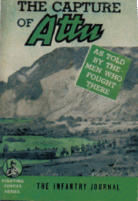The Landing of the Artillery
as Told By
Staff Sergeant Stanley E. West
Staff Sergeant Allen W. Robbins
Corporal Howard B. Campbell
Battery C, 48th Field Artillery Battalion
The advance party with Lieutenant James West were already moving up Massacre Valley
into the fog, when the barges with the big 105mm. rifles and the heavy cats crunched
against the sand of the beach. The motors roared and the cats backed the big guns out of
the barges onto Attu.
In a few minutes they had turned around and were struggling over the steep bank up from
the beach. Three of the guns had landed, and one was still coming in from the ship. The
battery was busy getting up its own fire-direction center, as the big tractors lumbered onto
the spongy, yielding tundra dragging the guns slowly behind. About seventy-five yards
from the beach the treads of the first cat chewed through the tundra and began to slip. In
just seconds it was wallowing helplessly in the black oozy mud. The other two cats soon
shared the same fate. When the tundra broke, the big treads turned round and round and
only dug the machine deeper into the mud. What the hell, seventy-five yards was far
enough initially! The crews swung the big guns around and pointed them into the valley.
They were setting up.
The radio to the advance party popped back into life. The tin voice Said, ". . . encountered
no enemy " The crews went ahead rapidly setting up the big guns. Lieutenant William
Kimball was on the radio, the guns were getting ready. The first half hour passed. "No
enemy . . . " And Kimball said, "For Christ's sake, find something!" The guns were set, and
the crews were moving ammunition in when the 610 (Field Artillery portable radio set)
spoke again, Lieutenant West's voice, "Enemy mortar position . . . map target 10." The
battery knew where the target was, on the map, but they didn't know exactly where the
guns were on the map's beach. The FDC (Fire Direction Center) popped a pin into the map,
took a deflection reading off the fan for target 10. The guns were already laid up the valley
in the general direction of the enemy. Lieutenant Kimball was shouting, "No. 1, adjust . . .
shell HE . . . charge five . . . fuze quick . . . base deflection . . . left two zero . . . elevation
three two zero . . ."
Eager fingers moved over the gun making adjustments. Then Private First Class Roy W.
Watson said, "Set!" and Corporal Billie V. Vannoy, "Ready!" Lieutenant Kimball sang into the
radio. "One on the way," then "Fire!" and the big gun slammed back into recoil. The trail log
jumped eighteen inches into the boggy mud. The first round of artillery was whistling
through the Attu sky toward the enemy.
For a long thirty seconds everybody waited, then the radio spoke, "eight hundred right . . .
five hundred over." The computers, Staff Sergeant Stanley West and Corporal Howard
Campbell, flipped the figures a moment converting the yards into millimeters. The muzzle
of the big rifle moved slightly to the left and down. Lieutenant Kimball called, "Fire!" The
trail log hunched deep into the mud as the gun roared another round at the unseen Japs
ahead in the fog. The radio spoke again, "one hundred right . . . two hundred over," and
again these figures were changed to millimeters and the big gun adjusted. The third round
ripped into the enemy mortar position, and far up the valley Lieutenant West watched the
burst as he reported, "Fire for effect!" When Lieutenant Kimball called out, "Battery, three
rounds . . . "and the three guns roared in unison, Section Chief No. 1, Staff Sergeant Allen
W. Robbins, looked over at Vannoy, his gunner, and grinned, "This is it, boy; we're gunnin'."
That was it. The beginning of twenty-one long, backbreaking, cold days and nights of
fighting they would never forget.
An extract from "The Capture of Attu," As Told By The Men Who Fought There. From the
Fighting Forces Series of The Infantry Journal, 1115 Seventeenth Street, N.W., Washington ,
DC.




